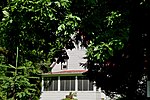MapInfo Corporation
1986 establishments in New York (state)American companies established in 1986Companies based in New York (state)GIS software companiesSoftware companies established in 1986

MapInfo Corporation, initially incorporated as Navigational Technologies Incorporated, was a company that developed location intelligence software. It was headquartered in North Greenbush, New York. Its products included a desktop mapping application, various map and demographic data products, and some web-based applications. It acquired several other companies in order to market their software, data, or services directly. It was acquired in 2007 by Pitney Bowes, and became Precisely in December 2019 when acquired by Syncsort.
Excerpt from the Wikipedia article MapInfo Corporation (License: CC BY-SA 3.0, Authors, Images).MapInfo Corporation
Global View, Troy
Geographical coordinates (GPS) Address Nearby Places Show on map
Geographical coordinates (GPS)
| Latitude | Longitude |
|---|---|
| N 42.682916666667 ° | E -73.702916666667 ° |
Address
Pitney Bowes Software
Global View 1
12180 Troy
New York, United States
Open on Google Maps





